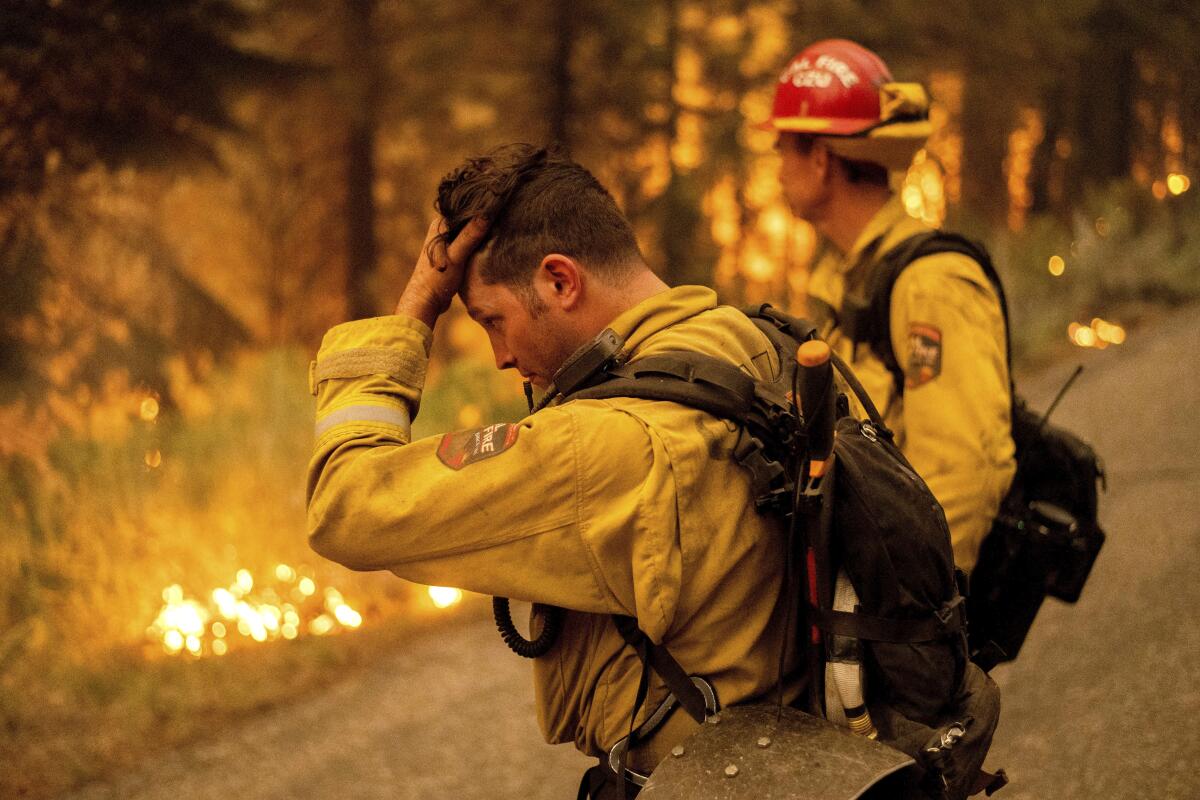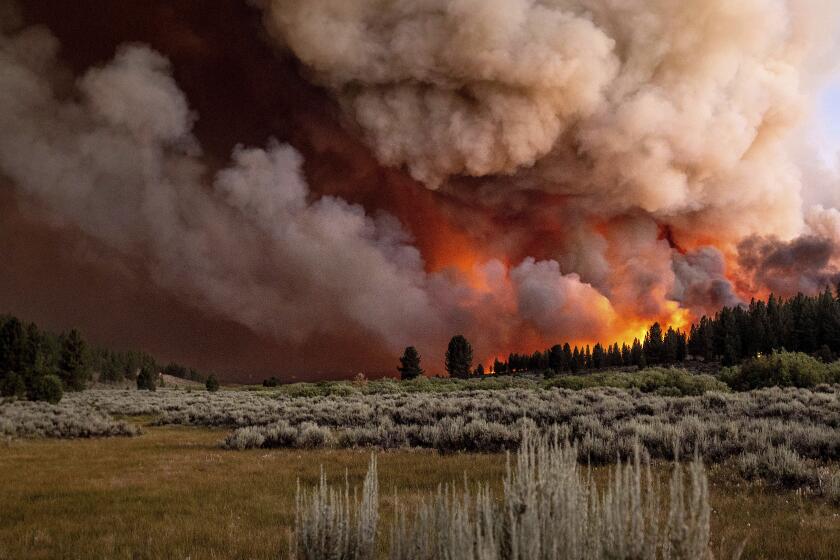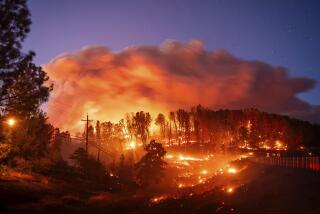Northern California wildfires merge, forcing more from their homes

- Share via
California’s largest wildfire so far this year merged with another, smaller fire overnight, swelling to 192,849 acres by Sunday evening as it burned through some area neighborhoods.
Authorities on Sunday issued new evacuation orders as the massive Dixie fire in Butte County, north of Sacramento, continued to spread rapidly to the north and east and burned together with the nearby Fly fire, which had previously scorched about 4,300 acres.
“Right now, with the weather getting hotter and drier, the fire is moving faster,” Luis Jimenez, public information officer on the fire, said Sunday afternoon.
The incident meteorologist warned firefighters that unstable atmospheric conditions could help the fire generate a pyrocumulonimbus cloud capable of creating its own lightning, he said.
“The whole thing is basically picking up and going, and we’re trying to get that box, trying to corral the fire,” Jimenez said. “It’s been like that since Day One.”
Already, the fire had destroyed at least 16 structures, but damage assessment teams hadn’t been able to get into the areas it burned through Saturday to provide updated numbers, Jimenez said.
About 5,022 firefighting personnel were able to boost containment of the fire on Sunday to 21%, up from 14% the day before, with most of the progress at its heel near where it started, Jimenez said.
Pacific Gas & Electric Co. has said its equipment might have sparked the fire in Feather River Canyon on July 13. A worker wasn’t able to get to the site and discover the flames until nine and a half hours later, PG&E said.
The fire’s growth has been fed by record-dry vegetation, low humidity and gusty winds funneling through the steep terrain. Efforts to fight it have been hampered by the remote location and an intensity that has lent itself to extreme behavior, with the fire at times creating its own weather patterns.
The fire is one of several in the West that has burned unusually fiercely for this early in the season, with authorities saying the conditions on the ground are more closely resembling those typically seen at the peak of the fire season in August or September.
The largest wildfire, the 408,930-acre Bootleg fire in Oregon, was burning so quickly through dry vegetation at one point last week that when atmospheric conditions aligned, a tornado formed along its eastern perimeter, officials confirmed Saturday. The fire was 46% contained as of Sunday evening.
Experts have said the environment across much of the Western U.S. is primed to burn because of the persistent drought and historic heat. Rising global temperatures have been linked to larger, more intense fires and longer, more destructive fire seasons, especially in areas choked by overgrowth due to decades of aggressive fire suppression.
Fueled by a heat wave that exacerbated already hot, dry conditions, the Sugar fire made a huge run Friday, triggering new evacuations for portions of Plumas and Lassen counties.
Authorities reported progress against the Tamarack fire, east of Sacramento, burning in both California and Nevada. The fire was 66,744 acres and 27% contained as of Sunday evening, up from 4% contained the day before.
“Saturday, the winds calmed down and that gave us the opportunity to go direct,” said Mike DeFries, public information officer on the fire.
Authorities were able to insert firefighters in several locations along the fire’s edge to engage the flames and secure containment lines, he said.
Smoke continued to pose a challenge. A good amount of it was coming from the Dixie fire, burning more than 100 miles away, compromising visibility and at times limiting the types of firefighting aircraft that could be in the air, DeFries said.
Forecasters were also calling for a monsoonal moisture surge pushing up from the south to arrive in the area Monday, which could bring thunderstorms that generate dry lightning or outflow winds.
“Our firefighters have been warned to be ready if storms are in the area because there may be a burst of strong, even extreme gusts of wind that pushes through from the storm coming from elsewhere nearby,” DeFries said.
About 1,557 personnel were continuing to fight the fire, which had destroyed at least 14 structures, he said.
“This fire has really been challenging, and there’s a lot of people that have been evacuated so it’s very significant to be able to announce a jump in containment today,” DeFries said. “And we’re hoping in the next couple of days to be able to announce even more significant gains.”
The Tamarack fire was sparked by lightning in the Mokelumne Wilderness on July 4 and at first, only a single tree was ablaze. Federal firefighting authorities initially decided to monitor the fire.
But 12 days later amid high winds and low humidity, the fire took off and made a run downslope. It is now one of 86 large fires currently burning that have together torched about 1.5 million acres in 12 states, according to the National Interagency Fire Center.
More to Read
Sign up for Essential California
The most important California stories and recommendations in your inbox every morning.
You may occasionally receive promotional content from the Los Angeles Times.












